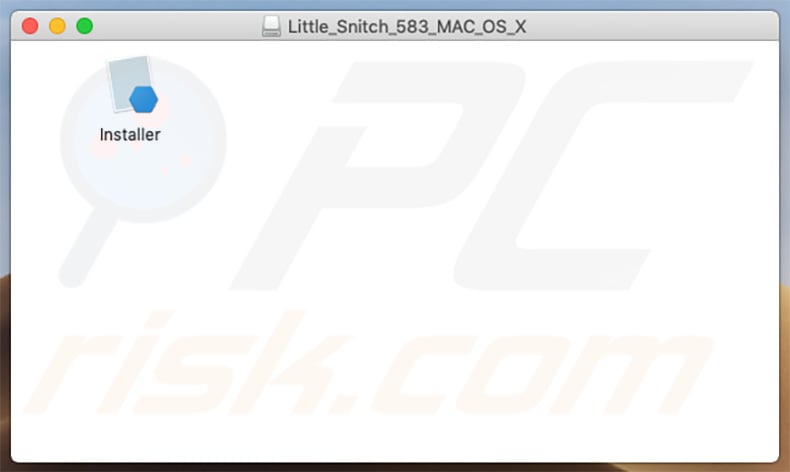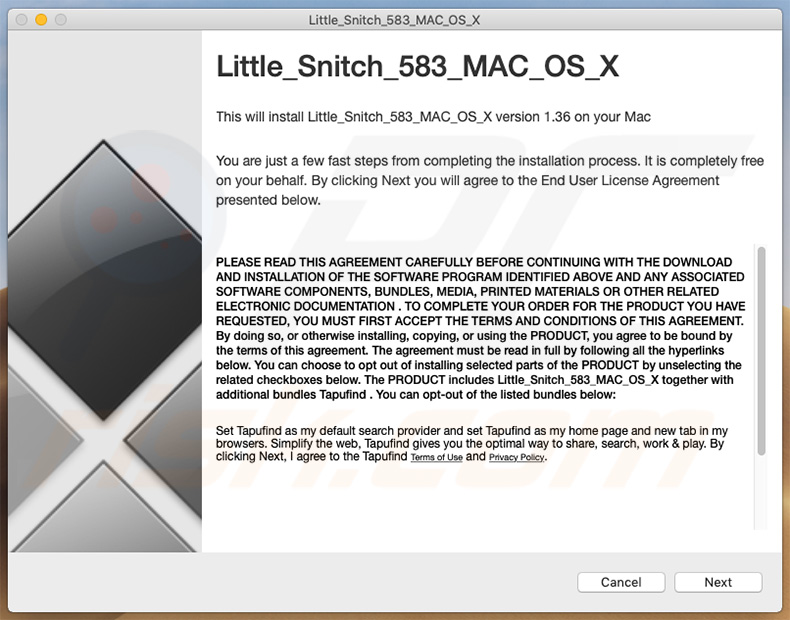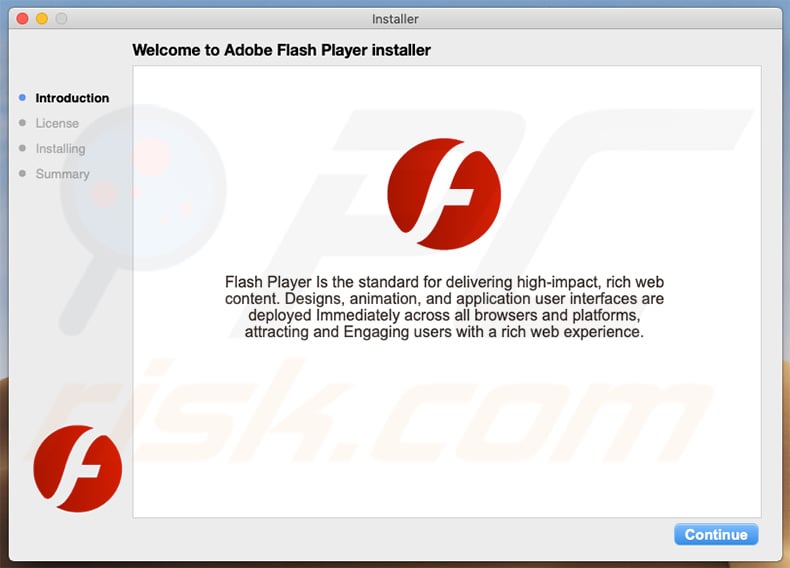How to remove the "Mac EXE Virus" from your operating system
Mac VirusAlso Known As: Mac EXE malware
Get free scan and check if your device is infected.
Remove it nowTo use full-featured product, you have to purchase a license for Combo Cleaner. Seven days free trial available. Combo Cleaner is owned and operated by RCS LT, the parent company of PCRisk.com.
What is "Mac EXE Virus"?
Mac EXE Virus is a rogue application that infiltrates Mac computers and gathers various system-related data. Note that this malware is proliferated using an executable (.exe or EXE) file, which is developed for the Windows Operating System. MacOS does not support this format by default.
This malware is distributed using an installation setup of a cracked Little Snitch version, which is a popular Mac/Windows Firewall app. Research shows that, as well as proliferating Mac EXE Virus, the cracked version of Little Snitch is also used to distribute adware and browser hijackers (e.g., TapuFind, Search Operator).

"Mac EXE Virus" overview
Mac EXE Virus functionality is rather basic. After successful infiltration, Mac EXE Virus immediately gathers various information about the system (the list of collected information is below) and sends it to a remote server. In addition, Mac EXE Virus checks if there are certain applications installed (the list of searched apps is below) and also sends details to a remote server.
Mac EXE Virus then connects to the remote server and downloads several files to the "~/Library/X2441139MAC/Temp/" directory. At time of research, Mac EXE Virus gathered information that is not particularly sensitive (e.g., processor details, memory, etc.), however, it is promoted using a quite unique malware distribution technique.
Therefore, there is a high probability that this virus is either still in development or is used to test whether the malware distribution method is effective. If Mac EXE Virus is still being developed, there is a high probability that it will start gathering more sensitive data, such as saved logins/passwords, browsing history, etc.
Furthermore, since it is capable of downloading various data, it might be used to proliferate other viruses. Therefore, this virus should be eliminated immediately.
| Name | Mac EXE malware |
| Threat Type | Mac malware, Mac virus |
| Symptoms | Your Mac became slower than normal, you see unwanted pop-up ads, you get redirected to shady websites. |
| Distribution methods | Deceptive pop-up ads, free software installers (bundling), fake flash player installers, torrent file downloads. |
| Damage | Internet browsing tracking (potential privacy issues), displaying of unwanted ads, redirects to shady websites, loss of private information. |
| Malware Removal (Windows) |
To eliminate possible malware infections, scan your computer with legitimate antivirus software. Our security researchers recommend using Combo Cleaner. Download Combo CleanerTo use full-featured product, you have to purchase a license for Combo Cleaner. 7 days free trial available. Combo Cleaner is owned and operated by RCS LT, the parent company of PCRisk.com. |
Similar software examples
The internet is full of malware that shares similarities with Mac EXE Virus (e.g., Speakup, Shlayer, CoinTicker, CookieMiner, and many others).
These viruses are developed by different cyber criminals and, thus, their behavior might also differ - some gather information, others misuse the system to stealthily mine cryptocurrency, proliferate viruses, or perform a number of these activities. In any case, all pose a direct threat to your privacy and browsing safety. Therefore, you should eliminate these threats immediately.
How did Mac Exe Virus infiltrate my computer?
As mentioned above, Mac EXE Virus is distributed using an executable (.exe) file (hence its name). This file format runs on the Windows Operating System.
Note that running it on Linux, MacOS, and other operating systems will not work - users will simply encounter an error, however, MacOS security systems (such as Gatekeeper) check only those files that run on MacOS (e.g., .dmg, .app, and so on). Therefore, formats such as .exe are not scanned. Therefore, cyber criminals can bypass the security systems.
The malicious Little Snitch installer, through which which Mac EXE Virus is promoted, is a MacOS application, however, its content includes the aforementioned executable. Installer also contains Mono - .NET framework-based software that is used to run Microsoft .NET applications on other platforms (such as MacOS, Linux, Android, Solaris, etc.).
Installer employs Mono to run the malicious executable which places the Mac EXE Virus virus into the system. As mentioned, this distribution method is quite unusual - malware of this type is often distributed using trojans, software cracks, and spam email campaigns. Trojans cause "chain infections" (they infiltrate computers and continually inject additional malware).
Spam campaigns proliferate viruses via malicious attachments. Criminals send hundreds of thousands of emails with deceptive messages and infectious attachments (e.g., PDFs, Microsoft Office documents, JavaScript files, or similar). They attempt to convince recipients into opening the attached files (or links that lead to these files), thus resulting in malware infections.
Software cracks bypass paid software activation, however, criminals often use these tools to proliferate malware. Rather than gaining access to paid features, users end up infecting their computers.
How to avoid installation of potentially unwanted applications?
Caution is the key to computer safety. Therefore, pay close attention when browsing the internet and downloading/installing software. We strongly recommend that you download applications from official sources only, using direct download links. Third party downloaders/installers are often used to proliferate viruses, and thus these tools should never be used.
Note that most set-ups that the Mac EXE Virus is distributed through are downloadable on various publicly-accessible torrent sites that are not safe. This is a clear example of cyber criminals proliferating malware through third party download sources. Keep installed applications updated.
To achieve this, however, use only implemented functions or tools provided by the official developer. Never use software cracking tools, since: 1) software piracy is considered a cyber crime, and; 2) there is a high risk of computer infections. Think twice before opening email attachments.
Files that are irrelevant and those received from suspicious/unrecognizable email addresses should never be opened. Having a legitimate anti-virus/anti-spyware suite installed and running at all times is also extremely important, since these tools can detect and eliminate malware before it does any harm.
If your computer is already infected with PUAs, we recommend running a scan with Combo Cleaner Antivirus for Windows to automatically eliminate them.
Screenshot of cracked Little Snitch installation setup:

Screenshot of a fake Adobe Flash Player installer which is executed by the rogue installer of Little Snitch:

List of data recorded by Mac EXE Virus:
- BootROMVersion
- Memory
- ModelIdentifier
- ModelName
- NumberofCores
- NumberofProcessors
- ProcessorDetails
- ProcessorSpeed
- SMCVersion
- SerialNumber
- UUID
List of apps checked by Mac EXE Virus:
App Store.app; Automator.app; Calculator.app; Calendar.app; Chess.app; Contacts.app; DVD Player.app; Dashboard.app; FaceTime.app; Font Book.app; Image Capture.app; Launchpad.app; Mail.app; Maps.app; Messages.app; Mission Control.app; Notes.app; Photo Booth.app; Photos.app; Preview.app; QuickTime Player.app; Reminders.app; Safari.app; Siri.app; Stickies.app; System Preferences.app; TextEdit.app; Time Machine.app; UtilitiesiBooks.app; iTunes.app
Instant automatic malware removal:
Manual threat removal might be a lengthy and complicated process that requires advanced IT skills. Combo Cleaner is a professional automatic malware removal tool that is recommended to get rid of malware. Download it by clicking the button below:
DOWNLOAD Combo CleanerBy downloading any software listed on this website you agree to our Privacy Policy and Terms of Use. To use full-featured product, you have to purchase a license for Combo Cleaner. 7 days free trial available. Combo Cleaner is owned and operated by RCS LT, the parent company of PCRisk.com.
Quick menu:
- What is "Mac EXE Virus"?
- STEP 1. Remove PUA related files and folders from OSX.
- STEP 2. Remove rogue extensions from Safari.
- STEP 3. Remove rogue add-ons from Google Chrome.
- STEP 4. Remove potentially unwanted plug-ins from Mozilla Firefox.
Video showing how to remove adware and browser hijackers from a Mac computer:
Potentially unwanted applications removal:
Remove potentially unwanted applications from your "Applications" folder:

Click the Finder icon. In the Finder window, select "Applications". In the applications folder, look for "MPlayerX","NicePlayer", or other suspicious applications and drag them to the Trash. After removing the potentially unwanted application(s) that cause online ads, scan your Mac for any remaining unwanted components.
DOWNLOAD remover for malware infections
Combo Cleaner checks if your computer is infected with malware. To use full-featured product, you have to purchase a license for Combo Cleaner. 7 days free trial available. Combo Cleaner is owned and operated by RCS LT, the parent company of PCRisk.com.
Remove adware-related files and folders

Click the Finder icon, from the menu bar. Choose Go, and click Go to Folder...
 Check for adware generated files in the /Library/LaunchAgents/ folder:
Check for adware generated files in the /Library/LaunchAgents/ folder:

In the Go to Folder... bar, type: /Library/LaunchAgents/

In the "LaunchAgents" folder, look for any recently-added suspicious files and move them to the Trash. Examples of files generated by adware - "installmac.AppRemoval.plist", "myppes.download.plist", "mykotlerino.ltvbit.plist", "kuklorest.update.plist", etc. Adware commonly installs several files with the exact same string.
 Check for adware generated files in the ~/Library/Application Support/ folder:
Check for adware generated files in the ~/Library/Application Support/ folder:

In the Go to Folder... bar, type: ~/Library/Application Support/

In the "Application Support" folder, look for any recently-added suspicious folders. For example, "MplayerX" or "NicePlayer", and move these folders to the Trash.
 Check for adware generated files in the ~/Library/LaunchAgents/ folder:
Check for adware generated files in the ~/Library/LaunchAgents/ folder:

In the Go to Folder... bar, type: ~/Library/LaunchAgents/

In the "LaunchAgents" folder, look for any recently-added suspicious files and move them to the Trash. Examples of files generated by adware - "installmac.AppRemoval.plist", "myppes.download.plist", "mykotlerino.ltvbit.plist", "kuklorest.update.plist", etc. Adware commonly installs several files with the exact same string.
 Check for adware generated files in the /Library/LaunchDaemons/ folder:
Check for adware generated files in the /Library/LaunchDaemons/ folder:

In the "Go to Folder..." bar, type: /Library/LaunchDaemons/

In the "LaunchDaemons" folder, look for recently-added suspicious files. For example "com.aoudad.net-preferences.plist", "com.myppes.net-preferences.plist", "com.kuklorest.net-preferences.plist", "com.avickUpd.plist", etc., and move them to the Trash.
 Scan your Mac with Combo Cleaner:
Scan your Mac with Combo Cleaner:
If you have followed all the steps correctly, your Mac should be clean of infections. To ensure your system is not infected, run a scan with Combo Cleaner Antivirus. Download it HERE. After downloading the file, double click combocleaner.dmg installer. In the opened window, drag and drop the Combo Cleaner icon on top of the Applications icon. Now open your launchpad and click on the Combo Cleaner icon. Wait until Combo Cleaner updates its virus definition database and click the "Start Combo Scan" button.

Combo Cleaner will scan your Mac for malware infections. If the antivirus scan displays "no threats found" - this means that you can continue with the removal guide; otherwise, it's recommended to remove any found infections before continuing.

After removing files and folders generated by the adware, continue to remove rogue extensions from your Internet browsers.
Remove malicious extensions from Internet browsers
 Remove malicious Safari extensions:
Remove malicious Safari extensions:

Open the Safari browser, from the menu bar, select "Safari" and click "Preferences...".

In the preferences window, select "Extensions" and look for any recently-installed suspicious extensions. When located, click the "Uninstall" button next to it/them. Note that you can safely uninstall all extensions from your Safari browser - none are crucial for regular browser operation.
- If you continue to have problems with browser redirects and unwanted advertisements - Reset Safari.
 Remove malicious extensions from Google Chrome:
Remove malicious extensions from Google Chrome:

Click the Chrome menu icon ![]() (at the top right corner of Google Chrome), select "More Tools" and click "Extensions". Locate all recently-installed suspicious extensions, select these entries and click "Remove".
(at the top right corner of Google Chrome), select "More Tools" and click "Extensions". Locate all recently-installed suspicious extensions, select these entries and click "Remove".

- If you continue to have problems with browser redirects and unwanted advertisements - Reset Google Chrome.
 Remove malicious extensions from Mozilla Firefox:
Remove malicious extensions from Mozilla Firefox:

Click the Firefox menu ![]() (at the top right corner of the main window) and select "Add-ons and themes". Click "Extensions", in the opened window locate all recently-installed suspicious extensions, click on the three dots and then click "Remove".
(at the top right corner of the main window) and select "Add-ons and themes". Click "Extensions", in the opened window locate all recently-installed suspicious extensions, click on the three dots and then click "Remove".

- If you continue to have problems with browser redirects and unwanted advertisements - Reset Mozilla Firefox.
Frequently Asked Questions (FAQ)
What is the purpose of an unwanted application?
Unwanted software is designed to generate revenue for their developers. Profit may be made by promoting in-app purchases, gathering/selling private data, displaying ads, generating redirects, etc.
Is having "Mac EXE Virus" on my computer dangerous?
Mac EXE Virus collects system information and may target sensitive user data (e.g., browsing histories, log-ins/passwords, credit card numbers, etc.). The presence of such software on devices may result in severe privacy issues, financial losses, and even identity theft.
Will Combo Cleaner help me remove "Mac EXE Virus"?
Yes, Combo Cleaner is designed to detect and eliminate all manner of threats. It will scan your device and remove all unwanted/malicious applications. It must be mentioned that manual removal (unaided by security software) might not be a perfect solution. In some cases, manual removal leaves behind various file remnants. Furthermore, the remaining components may continue to run and cause issues. Therefore, it is essential to eliminate software thoroughly.
Share:

Tomas Meskauskas
Expert security researcher, professional malware analyst
I am passionate about computer security and technology. I have an experience of over 10 years working in various companies related to computer technical issue solving and Internet security. I have been working as an author and editor for pcrisk.com since 2010. Follow me on Twitter and LinkedIn to stay informed about the latest online security threats.
PCrisk security portal is brought by a company RCS LT.
Joined forces of security researchers help educate computer users about the latest online security threats. More information about the company RCS LT.
Our malware removal guides are free. However, if you want to support us you can send us a donation.
DonatePCrisk security portal is brought by a company RCS LT.
Joined forces of security researchers help educate computer users about the latest online security threats. More information about the company RCS LT.
Our malware removal guides are free. However, if you want to support us you can send us a donation.
Donate
▼ Show Discussion